Thick Film Resistor Market Size
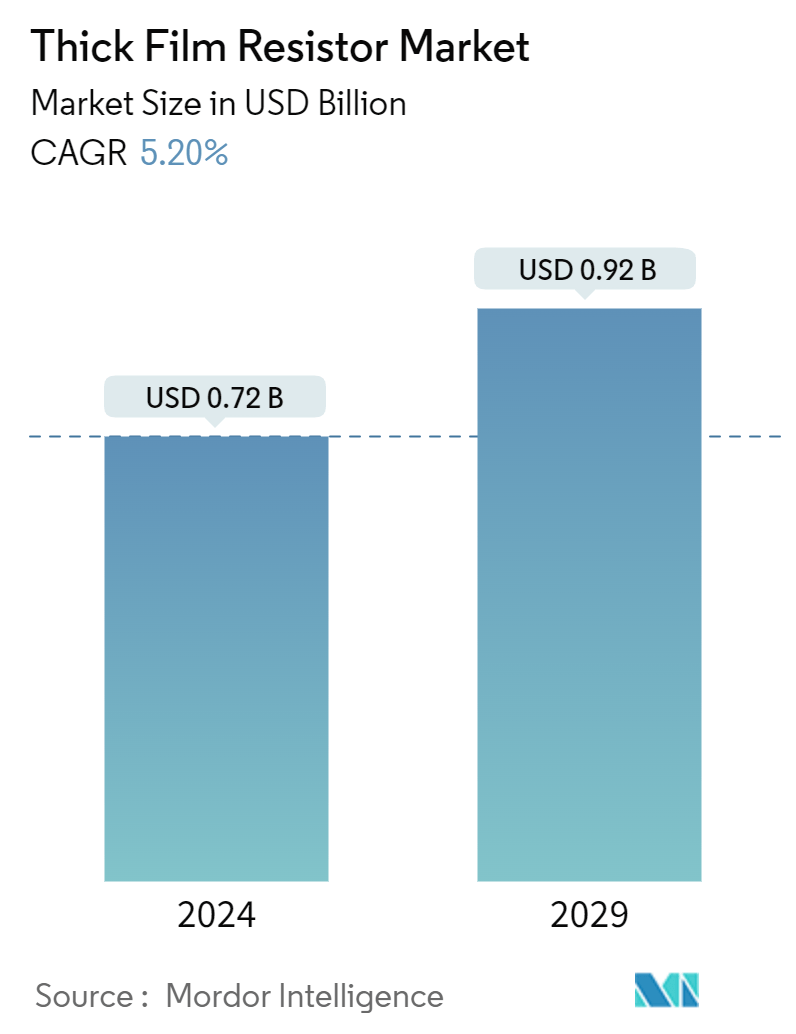
| Study Period | 2019 - 2029 |
| Market Size (2024) | USD 0.72 Billion |
| Market Size (2029) | USD 0.92 Billion |
| CAGR (2024 - 2029) | 5.20 % |
| Fastest Growing Market | Asia Pacific |
| Largest Market | North America |
| Market Concentration | Medium |
Major Players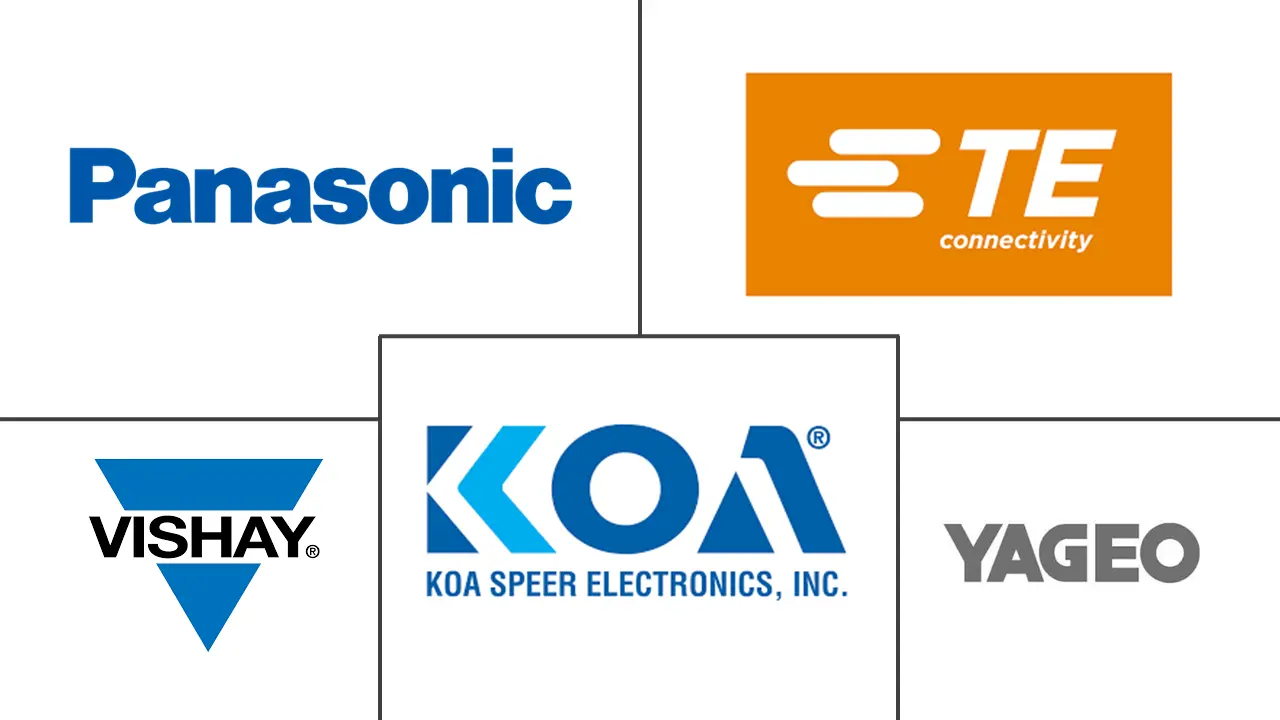
*Disclaimer: Major Players sorted in no particular order |
Thick Film Resistor Market Analysis
The Thick Film Resistor Market size is estimated at USD 0.72 billion in 2024, and is expected to reach USD 0.92 billion by 2029, growing at a CAGR of 5.20% during the forecast period (2024-2029).
One of the primary factors driving the Thick Film Resistor Market is that resistor manufacturers are extensively investing in research & development to improve the efficiency of thick film resistors.
- Another factor driving the Thick Film Resistor Market is the rapid rise of the consumer electronics and automotive markets. Thick film resistors are one of the most common main components found in automotive and consumer electronics applications. The global Thick Film Resistor Market is expected to grow further as consumer spending and global investment increase.
- Rising IC, electric, and hybrid vehicle sales, as well as government regulations to improve fuel efficiency and safety standards, have prompted OEMs to install more electrical and electronic devices, driving the market in the automotive industry. Furthermore, robust technological advancements in electronic goods and the increasing adoption of fast networks (4G/5G networks) around the world have increased demand for products containing thick film power resistors. These factors are expected to drive the thick film resistor market this year.
- Furthermore, due to its broad application in the electric and hybrid vehicle segments, hybrid electric vehicles are expected to outperform thick-film and shunt resistors. The HEV has an internal combustion engine, an electric drive system, and a broader array of other technologies, such as regenerative braking, enhanced engine assistance, actuators, and an autonomous start/stop system.
- These technologies necessitate more complex electrical and electronic equipment for extra power. Implementing such technologies, combined with the increased demand for HEVs, would boost the market for thick layers and shunt resistors. In August 2023, China sold a total of 846,000 new energy vehicles. Of these, 808,000 were passenger electric vehicles, while the remaining 39,000 were commercial electric vehicles.
- On the flip side, thick film resistors present several manufacturing and performance challenges. For example, different laser trim designs and shapes present different manufacturing challenges and yield different strengths and weaknesses in the performance of the resistor. Further, Thick film resistors can be sensitive to environmental and thermal effects, which can cause performance degradation or failure over time. Working with low ohmic values can be challenging for designers, especially in maintaining dimensional accuracy and minimizing fluctuations in resistance.
Thick Film Resistor Market Trends
Automotive Segment is Expected to Hold Significant Market Share
- Thick film resistors are commonly used in automotive applications due to their high reliability and stability in harsh environments. They provide high heat, moisture, and shock resistance, making them suitable for use in automotive electronic circuits. Automotive-grade thick film chip resistors are widely available in size 12, resistance values, and working voltages. These resistors are often AEC-Q200 compliant, meaning that they meet the rigorous testing and requirements set by the Automotive Electronics Council (AEC) for use in automotive applications.
- Further, thick film resistors are commonly used in electric vehicles, particularly hybrid ones. They offer high power density, stability, and reliability in a compact package, making them an ideal choice for voltage conversion, battery management, and motor control applications. Additionally, thick film resistors can assist in reducing the final cost of the end product 1, making them an attractive option for manufacturers looking to optimize both performance and cost efficiency in their electric vehicles.
- The EV sales have increased in 2022, according to International Energy Agency, and accounted for a 1.02 million number of electric vehicles. Such instances indicate the growing demand for Thick film resistors in the automotive sector. Further, the high adoption of EVs to completely phase out dates of ICE engines set by various governments will drive the growth of thick film resistors in the automotive sector.
- ADAS use a range of sensors and technologies to enhance safety and improve driving experience. Thick film resistors are often used in measuring and regulating current to different components in ADAS, such as cameras, sensors, and control units. They are valued for their precision, stability, and durability in harsh environments. Some examples of ADAS applications that use thick film resistors include telematics control units, ADAS cameras, body electronics, and battery management systems. According to World Economic Forum, more than 12 million fully autonomous cars are expected to be sold annually by 2035, covering 25% of the global automotive market. This would create an opportunity for the studied market to grow.
- Moreover, Automotive thick film resistors are utilized in a variety of applications in automobiles. The resistor aids in the control of current and voltage flow in circuits. It also contributes to the stability of the electrical system by dispersing heat energy. Furthermore, it prevents damage to other vehicle components caused by excessive heat generation. Furthermore, these resistors are used to measure electrical signals. As a result, they play a crucial role in assuring the safety and proper operation of automobiles. According to BEA (Bureau of Economic Analysis), In 2022, the United States will produce around 1.8 million automobiles. This reflects an increase of around 13% over the previous year. Such huge production would create an opportunity for the studied market to grow.
- To meet the various demands of the customers, the firms in the market are providing various products. For example, Yageo's automotive grade, double power thick film chip resistors are available in case sizes ranging from 0402 to 1206, with resistance ranges of 1 - 22M, tolerances of 0.5%, 1%, 5%, and TCRs of 100, 200 ppm/°C, and power ratings ranging from 1/8 W to 1/2 W. Established systems such as engine control, power steering, gearbox, climate control, lighting, and ABS are undergoing massive changes. Still, relatively new systems such as car-to-car communications, driver assistance, self-steering, and self-parking are also undergoing similar transformations that necessitate more resistors and capacitors. Deeper integration within the automotive environment pushes passive component performance to the limit.
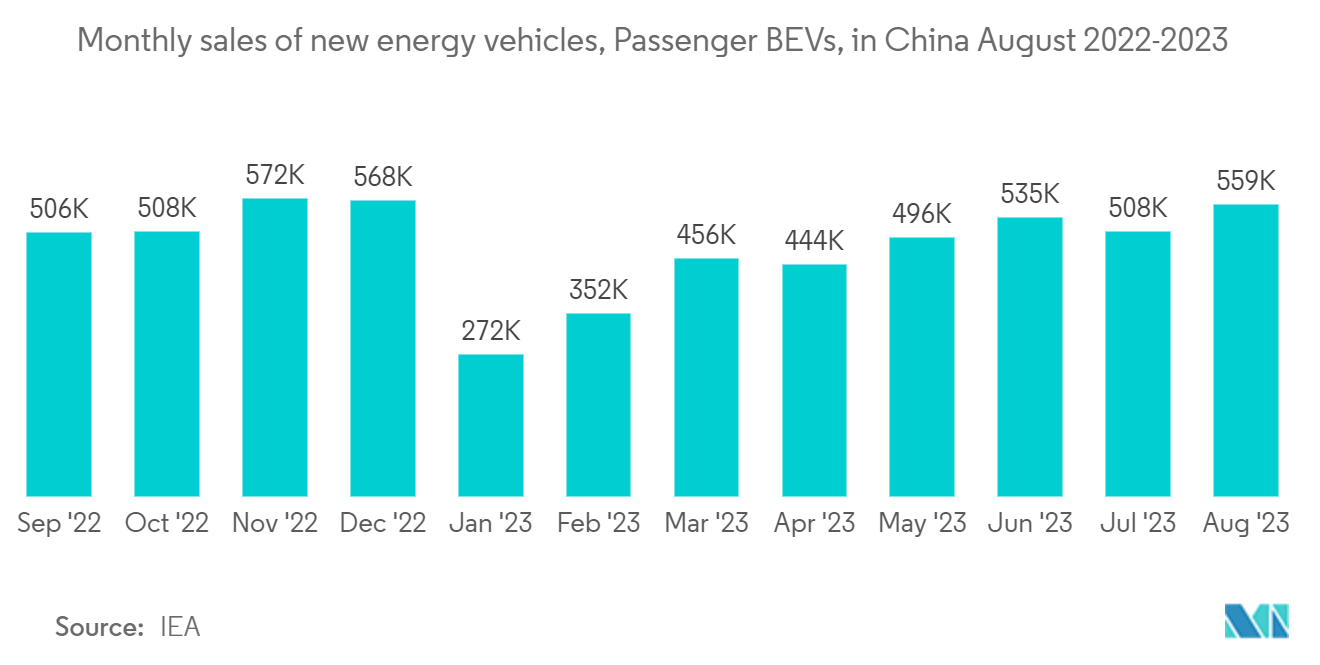
Asia Pacific Region is Expected to Witness a High Market Growth
- The Asia-pacific region is one of the most important markets for thick film resistors owing to the rapid growth in the region's telecom, consumer electronics, and automotive industries. The automotive industry is proliferating in China, and the country is playing a critical role in the global automotive market. The Chinese government regards its automotive industry, along with the auto parts sector, as one of its country's crucial industries. The Central Government of China estimates that China's automobile output would reach 30 million units by 2020 and 35 million units by 2025, which is expected to drive studied market demand.
- Additionally, 5G would play a pivotal role as automakers strive to incorporate vehicles into the Internet of Things. Asia-Pacific's increasing 5G infrastructure and service initiatives would offer lucrative opportunities for autonomous vehicles to penetrate the region, thereby boosting the growth of the studied market.
- Moreover, the government of Japan is striving to triple the availability of 5G services in the country over the next two years (2023-2025). The government plans to cover 95% of the Japanese population by March 2024. Mobile carriers in Japan have prioritized developing their networks in urban areas since the introduction of 5G in the year 2020. But only 30% of the population has access to the new and advanced technology. The communications ministry carried out consultations with local telecom firms and has established a goal of achieving 95% coverage by the end of fiscal 2023, 97% by fiscal 2025, and 99% by fiscal 2030. Such instances would boost the adoption of thick film resistors.
- Thick film resistors are widely used in the consumer electronics industry due to their low cost and high reliability. They are often used in surface mount devices, heating elements, and integrated passive devices. Thick-film technology can also manufacture large-tolerance capacitors and resistors compatible with surface-mount technology (SMT). According to the National Bureau of Statistics of China, China produced approximately 32.66 million completed computers in April 2022. Such huge production of consumer products would drive the studied market.
- The players in the market are developing new products to cater a wide range of needs of the customer. For example, recently, ROHM has designed LTR100L thick-film shunt resistors for industrial and consumer applications. Shunt resistors, which are frequently employed to detect current in battery protection and motor drive circuits, require increased accuracy to improve reliability and assure high-efficiency operation. Energy savings have been emphasized in the industrial and consumer sectors in recent years, with attempts being made to cut power consumption during drive operation by employing motor inverters. At the same time, as the power of applications increases, protective circuits become more vital in these domains.
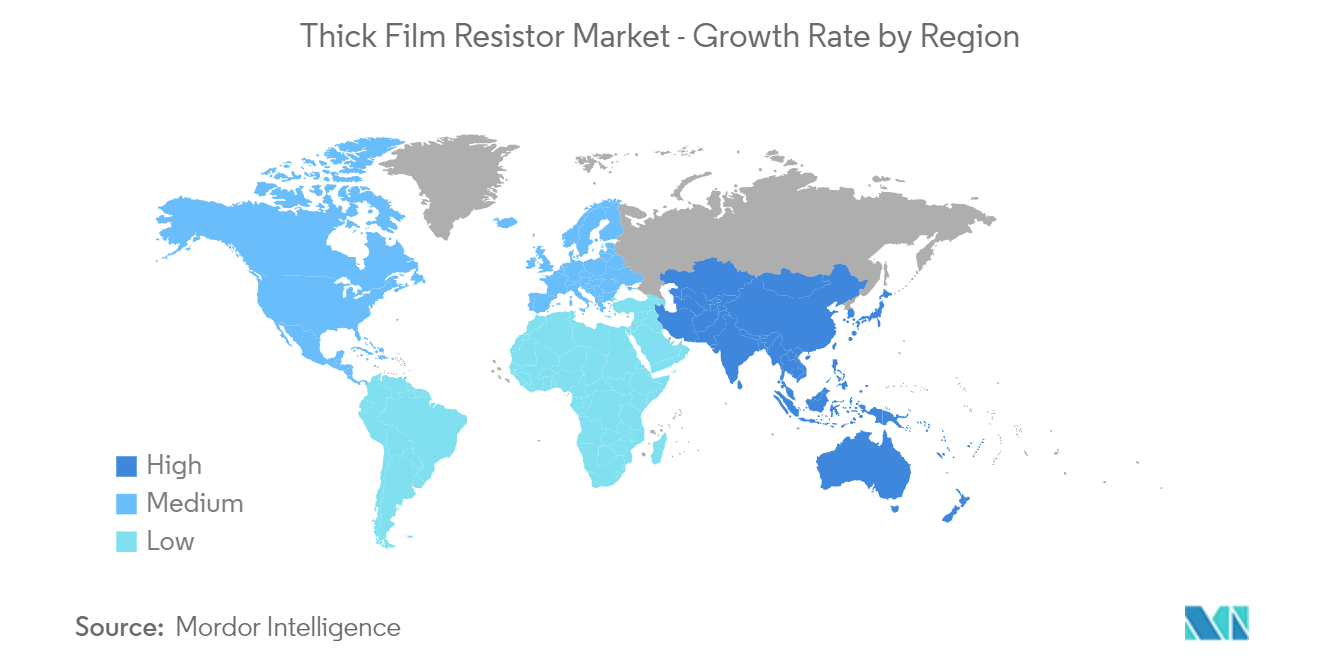
Thick Film Resistor Industry Overview
The thick film resistor resistors market is moderately consolidated owing to the presence of large vendors like CTS Corporation, Murata Manufacturing Co. Ltd, Panasonic Corporation, etc., in the global market. The key players are involved in various strategies, such as acquisitions and partnerships, to improve their market share and enhance their profitability in the market studied.
In March 2023, Vishay Intertechnology, Inc. announced that it had increased the power rating of the Vishay DraloricRCS0805 e3 anti-surge thick film resistor in the 0805-case size to 0.5 W. The RCS0805 e3's enhanced power rating allows it to replace four standard parallel resistors in the 0805 case size, two similar devices in the larger 1206 case size, or one resistor in the 1210 case size. Designers can decrease board space in automotive, industrial, telecommunications, and medical applications while cutting component counts and placement costs.
In February 2023, Bourns, Inc., a manufacturer and supplier of electronic components expanded its line of high-power thick film resistors with four new AEC-Q200 compliant product series. The new Model CRM-Q, CRS-Q, CMP-Q, and CHP-Q Series are automotive grade and are claimed to feature high-rated power and superior pulse load surge capability.
Thick Film Resistor Market Leaders
-
YAGEO Corporation
-
TE Connectivity
-
Panasonic Corporation
-
Vishay Intertechnology, Inc.
-
KOA Speer Electronics INC.
*Disclaimer: Major Players sorted in no particular order
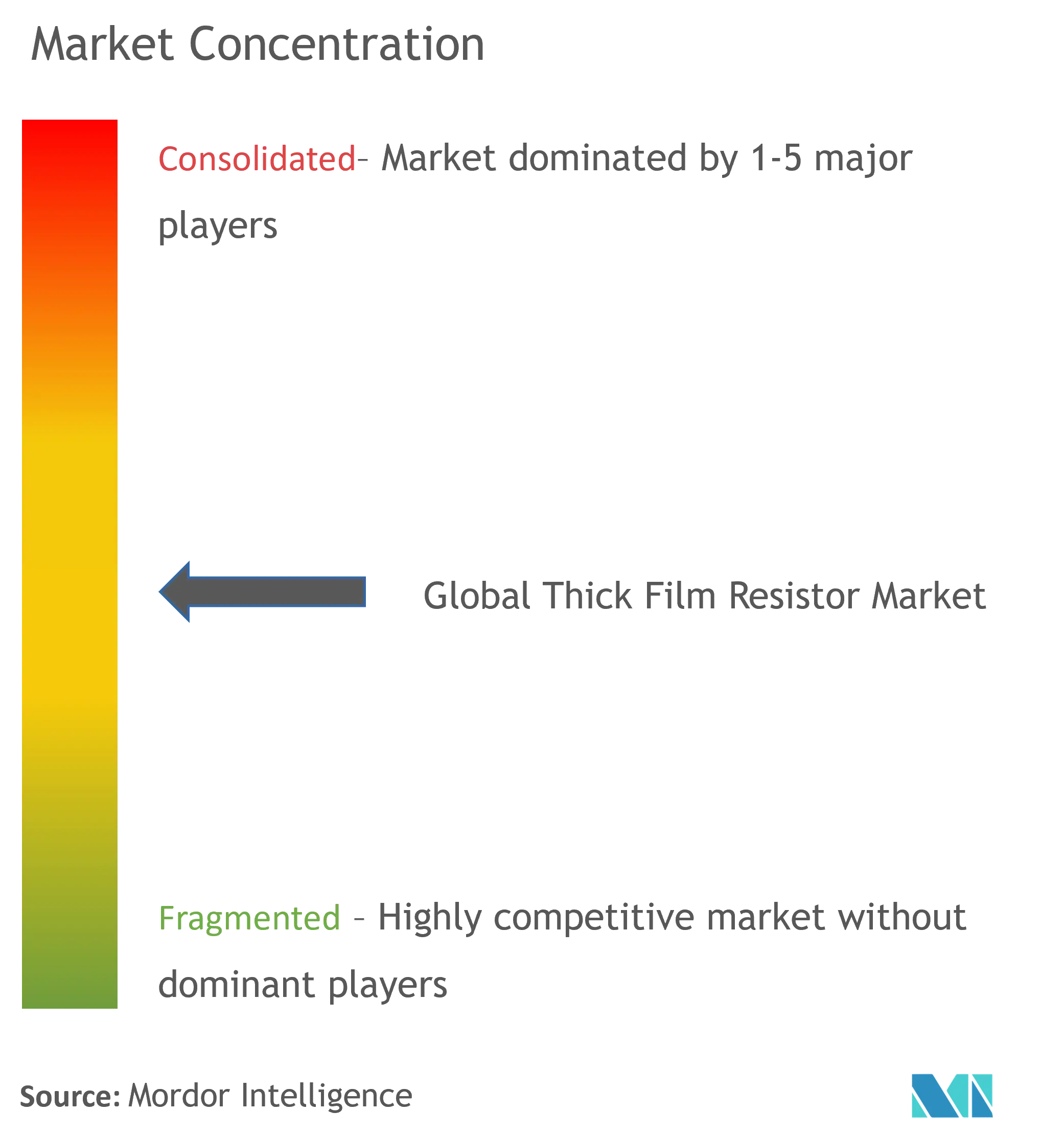
Thick Film Resistor Market News
- May 2024: Vishay Intertechnology, Inc. launched an upgraded version of its Vishay Draloric RCS0805 e3 anti-surge thick film resistor, now boasting a robust 0.5 W power rating. This enhancement empowers the RCS0805 e3 to replace four standard parallel resistors in the 0805 case size, two in the larger 1206 case, or a single resistor in the 1210 case.
- March 2024: FOJAN Electronics, a supplier to LCSC Electronics, launched the FRL Series Thick Film Resistor. These resistors, part of the FRL series, boast a compact size, lightweight build, and exceptional reliability. With their low resistance, they are particularly adept at handling high currents.
Thick Film Resistor Market Report - Table of Contents
1. INTRODUCTION
1.1 Study Assumptions and Market Definition
1.2 Scope of the Study
2. RESEARCH METHODOLOGY
3. EXECUTIVE SUMMARY
4. MARKET INSIGHTS
4.1 Market Overview
4.2 Industry Attractiveness - Porter's Five Forces Analysis
4.2.1 Bargaining Power of Suppliers
4.2.2 Bargaining Power of Buyers
4.2.3 Threat of New Entrants
4.2.4 Intensity of Competitive Rivalry
4.2.5 Threat of Substitutes
4.3 Value Chain Analysis
4.4 Assessment of Impact of COVID-19 on the Market
5. MARKET DYNAMICS
5.1 Market Drivers
5.1.1 Increasing demand for high performance electronic products
5.1.2 Rising adoption of 4G and 5G networks
5.2 Market Restrains
5.2.1 Fluctuating prices of raw materials
6. MARKET SEGMENATTION
6.1 By End-User Industry
6.1.1 Automotive
6.1.2 Electrical & Electronics
6.1.3 Telecommunication
6.1.4 Others
6.2 By Geography
6.2.1 North America
6.2.2 Europe
6.2.3 Asia
6.2.4 Australia and New Zealand
6.2.5 Latin America
6.2.6 Middle East and Africa
7. COMPETITIVE LANDSCAPE
7.1 Company Profiles
7.1.1 YAGEO Corporation
7.1.2 TE Connectivity
7.1.3 KOA Speer Electronics INC.
7.1.4 Panasonic Corporation
7.1.5 Vishay Intertechnology, Inc.
7.1.6 Rohm Semiconductor
7.1.7 Viking Tech Corporation
7.1.8 Murata Manufacturing Co. Ltd.
7.1.9 TT Electronics Plc
7.1.10 Bourns, Inc
- *List Not Exhaustive
8. INVESTMENT ANALYSIS
9. FUTURE OUTLOOK OF THE MARKET
Thick Film Resistor Industry Segmentation
A thick film resistor is characterized by a thick film resistive layer over a ceramic base. The appearance of this resistor is similar to the thin film resistor, but their properties and manufacturing procedure are different. The thickness of the studied resistor is 1000 times thicker than the thin-film resistor.
The thick film resistor market is segmented by end-user industry (automotive, electrical & electronics, telecommunication) and Geography (North America, Asia-Pacific, Europe, Latin America, Middle East & Africa). The market sizes and forecasts are provided in terms of value (USD) for all the above segments.
Thick Film Resistor Market Research Faqs
How big is the Thick Film Resistor Market?
The Thick Film Resistor Market size is expected to reach USD 0.72 billion in 2024 and grow at a CAGR of 5.20% to reach USD 0.92 billion by 2029.
What is the current Thick Film Resistor Market size?
In 2024, the Thick Film Resistor Market size is expected to reach USD 0.72 billion.
Who are the key players in Thick Film Resistor Market?
YAGEO Corporation, TE Connectivity, Panasonic Corporation, Vishay Intertechnology, Inc. and KOA Speer Electronics INC. are the major companies operating in the Thick Film Resistor Market.
Which is the fastest growing region in Thick Film Resistor Market?
Asia Pacific is estimated to grow at the highest CAGR over the forecast period (2024-2029).
Which region has the biggest share in Thick Film Resistor Market?
In 2024, the North America accounts for the largest market share in Thick Film Resistor Market.
What years does this Thick Film Resistor Market cover, and what was the market size in 2023?
In 2023, the Thick Film Resistor Market size was estimated at USD 0.68 billion. The report covers the Thick Film Resistor Market historical market size for years: 2019, 2020, 2021, 2022 and 2023. The report also forecasts the Thick Film Resistor Market size for years: 2024, 2025, 2026, 2027, 2028 and 2029.
Thick Film Resistor Industry Report
Statistics for the 2024 Thick Film Resistor market share, size and revenue growth rate, created by Mordor Intelligence™ Industry Reports. Thick Film Resistor analysis includes a market forecast outlook to for 2024 to 2029) and historical overview. Get a sample of this industry analysis as a free report PDF download.



